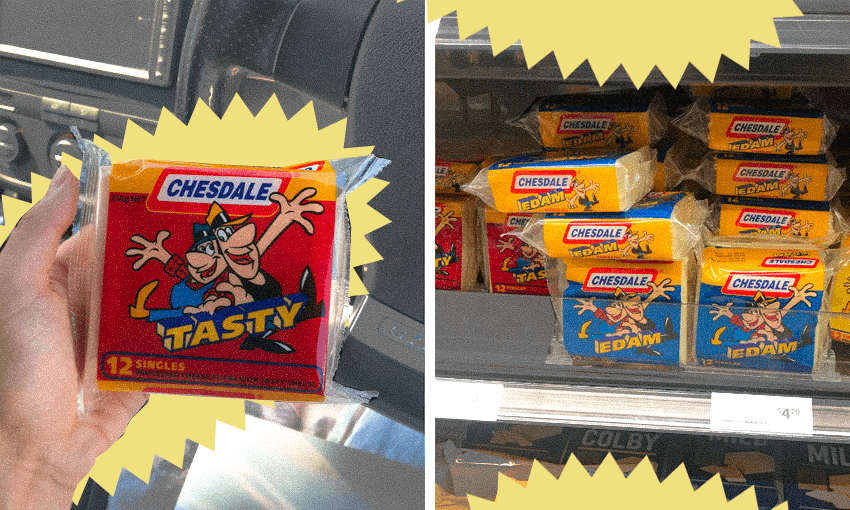Chesdale cheese slices were one of the banes of Charlotte Muru-Lanning’s childhood. Can she learn to love them as an adult?
This is an excerpt from our weekly food newsletter, The Boil Up.
For most of my childhood, Chesdale cheese slices were a mainstay in the fridge. Much to my disappointment. And they – alongside luncheon sausage and jam – became part of an internalised trio of lunchbox foods that kids were meant to like but that I, unfortunately, didn’t. It wasn’t even joyfully plastic in a vibrant orange American cheese kind of way. Instead, it was a pale, silken flop of a substance that seemed to only ever play the worst notes of tangy.
But yesterday, as I drove myself to an interview for the first time since passing my driver’s license, I found my mind drifting to the individually wrapped “cheese” slices. Perhaps it was the loose parallels between the cheese and industrialised car convenience as I sat in traffic while an air-conditioned train rattled past. Or it was one of the persistent nostalgic cravings that we all seem to be infected by lately. Maybe I was just hungry because I’d skipped lunch.
I wondered if Chesdale might be one of those foods that have an unjustly negative reputation among food snobs. Perhaps it could be the next happening cheese trend? I secured a packet, took them back to the car and ate a slice.
I want to say that it was some kind of profoundly romantic food moment where I realised this cheese was actually worth us all revisiting. But peeling back the plastic revealed something exactly as bad as I remembered.
It’s deeply unpopular to come to a negative conclusion on a mainstream food item, and the taste value of all food is of course subjective, but I couldn’t help but wonder, with the wide range of cheeses available these days, why is there still a market for this stuff?
I’ve not encountered a packet in our family fridge for at least a decade but a good place to start I thought, would be once loyal customers – my parents. When I asked my mum why they bought them in the first place, she responded with a list. “I had them when I was a kid”, “cheapish”, “cool advertising”, “easy to put in a lunch”, “didn’t really need to be refrigerated”. My dad, on the other hand, questioned their categorisation: “this stuff is not really ‘cheese’. It’s a reconstituted cheese-like substance”. But, he added with enthusiasm, “moreish!”
As it happens, this iconic cheese is almost a century old. Jack Butland, a businessman who founded NZ Cheese Ltd in 1926, discovered (on the back of discoveries of earlier food scientists from overseas) that adding sodium or potassium phosphate would give the cheese a smoother texture than the extraordinarily dry and sweaty cheeses that were ubiquitous in Aotearoa, and it went on sale as Chesdale Cheese the same year. It marked an industrialised swing in the building of New Zealand’s important cheese identity.
There have been several iterations over the years (most of which my mum can recall), including foil wrapped triangular segments rather than slices and a pineapple flavour. In 1969 its packets began featuring the beaming Ches and Dale characters. Like most processed cheeses, it contains a minimum of 55% cheese, cut with water, milk solids, emulsifiers, acidity regulator, salt, preservatives and colour.
When it comes to the topic of price, according to my survey of the cheese aisle, they’re cheaper than most other cheeses. Though, at $16.80 per kilogram compared to around $20 for 1kg of Tasty – it’s not by much. In fact, I thought that at $4.20, the 12 plastic sheathed singles were surprisingly pricy. Clearly, there are benefits too in that they’re relatively long lasting and convenient for parents, aged people and for people with disabilities.
All of this leaves me with a conundrum. Food media, myself included, has a growing and I think well-intentioned tendency to celebrate “low-brow” food culture – culinary preferences, practices and habits that “experts” stick up their noses at. But in the time of a cost of living and inequality crisis and a looming recession it’s hard to know whether that has positive or negative consequences. On the one hand, it’s a democratising opportunity to flip the script on who gets to define taste, and to celebrate the food that more of us have access to. At the same time I’m mindful that it runs the risk of forging acceptance of lower quality foods at exactly the same time we should be collectively demanding that everyone has access to good quality kai.
I guess the point is, in a country with this many cows, we should all be able to eat our favourite cheese – no matter what that happens to be.





